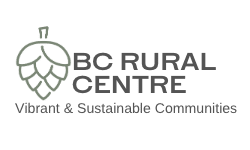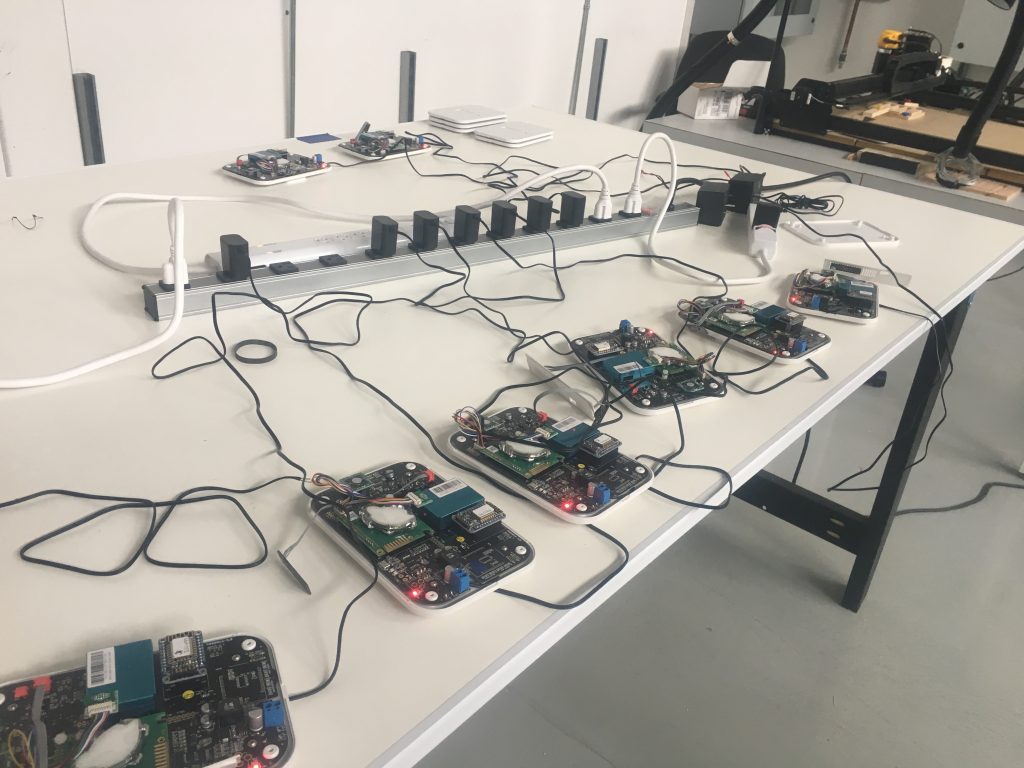
Tale of Three Cities — Rural BC Tech-Based Innovation
Innovation is about staying relevant. We are in a time of unprecedented change. As a result, what may have helped a community or organization be successful in the past could potentially be the cause of their failure in the future. Communities and companies need to adapt and evolve to meet the ever changing needs of their constituents.
— Stephen Shapiro
Innovation in rural BC — its importance, and how it can be deployed to help with everything from boosting local economies to coping with a changing climate — is a crucial issue.
When it comes to the importance of rural technology-based innovation in economic terms, Columbia University’s Norman Jacknis recently noted that, “The story is that the big cities have had almost all the economic gains of the last decade or so, while the economic life has been sucked out of small towns and rural areas. Yet we are in a digital age when everyone is connected to everyone else on the globe, thanks to the Internet. Why hasn’t this theory of economic potential from the Internet been true for the countryside? Well, it turns out that it is true. Those rural areas that do in fact have widespread access to the Internet are flourishing. These towns with broadband are exemplary, but unfortunately not the majority of towns.”
In a recent article published by Jacknis and Robert Bell based on research carried out by Professor Roberto Gallardo of Purdue’s Purdue Center for Regional Development, the authors argue that those rural communities with broadband and the wisdom to use it for quality of life will not die in this century. Here are some article highlights:
Millennial Trends
While metro areas still capture the majority of new jobs and population gains, there is some anecdotal evidence pointing in a different direction. Consider a CBS article that notes how, due to high housing costs, horrible traffic, and terrible work-life balances, Bend, Oregon, is seeing an influx of teleworkers from Silicon Valley. The New York Times has reported on the sudden influx of escapees from the Valley that is transforming Reno, Nevada – for good or ill, it is not yet clear.
Likewise, a Fortune article argued that “millennials are about to leave cities in drones” and the Telegraph mentioned “there is a great exodus going on from cities” in addition to Time magazine reporting that the millennial population of certain U.S. cities has peaked.
Why millennials? Well, dubbed the first digital-native generation, their migration patterns could indicate the beginning of a digital age-related decentralization.
Impact on the “Really Rural” County
“Urban” and “rural” can be tricky terms when it comes to demographics. The U.S. Census Bureau reports that 80% of the American population lives in urban areas. Seventy-five percent of those “urban” areas, however, are actually small towns with populations of under 20,000. They are often geographically large, with a population density that falls off rapidly once you leave the centre of town.
On the other hand, some rural counties are adjacent to metro areas and may benefit disproportionately from their location or even be considered metropolitan due to their commuting patterns. Because of this, we turned to another typology developed by the U.S. Department of Agriculture Economic Research Service that groups counties into nine types ranging from large metro areas to medium size counties adjacent to metro areas to small counties not adjacent to metro areas.
In counties considered completely rural or with an urban population of less than 2,500, not adjacent to a metro area (about 420 in total), those with the lowest digital divide experienced a 13.5 percent increase in millennials between 2010 and 2016. In other words, in America’s “most rural” counties, the millennial population increased significantly when those counties had better broadband access.
Conclusion
To conclude, if you just look at overall numbers, Americans (and Canadians, for that matter) seem to be behaving just like they did in the industrial age — moving to cities where jobs and people are concentrated. Rural areas that lag in broadband connectivity and digital literacy will continue to suffer from these old trends.
However, the digital age is young. Its full effects are still to be felt. Remember it took several decades for electricity or the automobile to revolutionize society. Besides, areas outside metro areas lag in broadband connectivity and digital literacy, limiting their potential to leverage the technology to affect their quality of life, potentially reversing migration trends.
Whether or not decentralization will take place remains to be seen. What is clear though is that (while other factors are having an impact, as well) any community attempting to retain or attract millennials need to address their digital divide, both in terms of broadband access and adoption/use.
In other words, Bell and Jacknis state, data analysis suggests that if a rural area has widely available and adopted broadband, it can start to successfully attract or retain millennials.
What About Rural BC?
There can be little doubt that innovation — perhaps particularly tech-driven innovation — is absolutely essential if small BC centres and regions located away from our major urban areas are to turn around recent demographic trends, and begin to attract younger residents away from big cities.
In this regard, broadband is essential. But there are other factors at play as well. High speed Internet on its own has little value in a community lacking in entrepreneurial, innovative individuals, organizations, small businesses, and local governments that understand its significance and have concrete ideas on how best to leverage it into game-changing revitalization.
In the following overviews and podcast, we explore the recent experiences of three small BC towns where innovation seems to be bubbling.
Salmon Arm — the Salmon Arm Innovation Centre
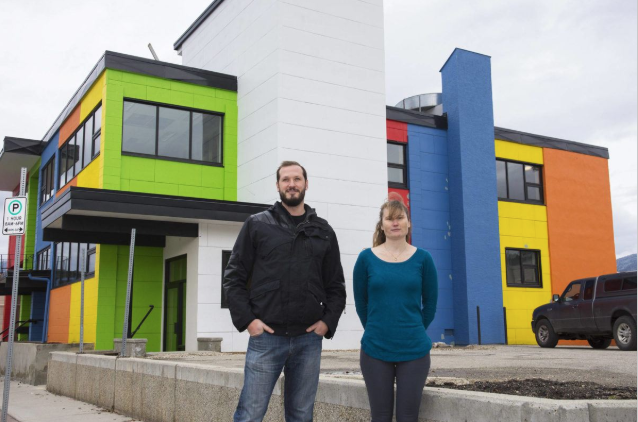
Chad Shipmaker & Lana Fitt in front of the Salmon Arm Innovation Centre
Excitement is brewing in the brightly coloured building that’s made its presence known on Shuswap Street. Not just a pretty facade, it will be home to the Salmon Arm Innovation Centre, a hub for the technology sector, business start-ups, innovation and collaboration for entrepreneurs. The idea of the Innovation Centre has been evolving for the last several years, says Lana Fitt, manager for the Salmon Arm Economic Development Society. It began with tech tables, where tech companies would talk about ways to expand Salmon Arm’s ‘tech cluster.
Something of a best-kept secret, 77 tech companies are located in Salmon Arm, says Development Society board member Chad Shipmaker, who joined the project as chair last summer. “It’s a bit of an unknown, something we’re trying to elevate. There are another 60 in the Shuswap. It’s a unique aspect of our community.” He undertook a feasibility study and business plan for the centre. Senior staff or owners of leading industry companies in Salmon Arm were interviewed. “That’s where we heard very clearly, almost without exception, every successful (tech) company in Salmon Arm started in Salmon Arm.” So the focus has been on expanding what is already happening in the area.
“We knew we were going to be challenged by competing with other urban centres – our biggest opportunity was building from within,” Shipmaker continued. A lot of innovation came out of Newnes’ wood processing equipment and systems, he says. In Trail, a similar “creation story” happened with Tech Cominco, with complementary businesses originating there. The Salmon Arm group visited other makerspaces in B.C. An online survey attracted 600 respondents in 72 hours. Key points gleaned from meetings and interviews were the importance of attracting and retaining talent, particularly young talent. Through meetings with a cross-section of the community including the school district, Okanagan College, and Community Futures, demands were crystallized and opportunities pinpointed.
“At the provincial level, they’re very keen on innovation; it’s a bit of a buzzword. I can say unequivocally, the gist of what’s going in here gets people excited – it’s like motherhood and apple pie. The challenge is, it’s receiving so much interest, we have to be disciplined about which ones to pursue,” says Shipmaker. Fitt and Shipmaker made a presentation at the Union of BC Municipalities convention in September 2017, which ramped up interest.
There are three floors on the building, each different but related. The lowest level houses a Community Makerspace, user-led and membership driven, providing access to shared equipment, knowledge and expertise. Members will pay a monthly fee or drop-in rate, just like a swimming pool or gym, Shipmaker says. There could be woodworking, electronics, robotics, possibly sound and animation. “We’ve done a survey recently about the kinds of things users would want. We’re trying to create the opportunity where people could get access where they didn’t before,” he says.
The school district provides opportunities such as coding and learning electronics. After students graduate, some stay in town. “That’s the demographic we have in mind; a place for youth in the community to continue to explore innovative technologies. Also newly retired people who have downsized,” says Fitt. Perhaps they might learn robotics, or how to use a 3-D printer.
“We’re creating the backbone and structure around it – tailoring it to what we’re hearing from the community. Over time it will evolve due to people’s wants,” adds Shipmaker. The main floor will be quite different. Shipmaker refers to what’s called a hot desk. “If you’re in town, you’re going houseboating, you’re an executive of Apple and you need a secretary and a meeting room, you can get a hot desk here,” he says. “I moved home and I was terribly unproductive – I had two young children. It’s a place where you could go and access free wifi, a boardroom, meeting rooms and, beyond that, a community. It means when you get off a call and come out to have a coffee, there are other people you can talk to. It’s a reason to get up and shower in the morning.”
In addition, the main floor will include a business accelerator program, where businesses can have access to mentorship, investors and other support. On the main floor will also be the offices of the Salmon Arm Economic Development Society, which will oversee what others need. On the third floor will be the anchor tenants – engineers, architects and accountants – professions that would be complementary to the community within. “I am getting more calls than we can address from people who want to be involved in some way,” Shipmakere says. “It’s really exciting. We have a database started of interested volunteers and their skill sets. And we’re having dialogue with different provincial ministries. There are so many opportunities.
We want to establish a hub for the community for cross-fertilization of ideas and innovation to support economic development and entrepreneurship in the community. This will be a vehicle for members of the community,” says Shipmaker. “Where it will lead is anybody’s guess.”
Revelstoke — the Mountain CoLab
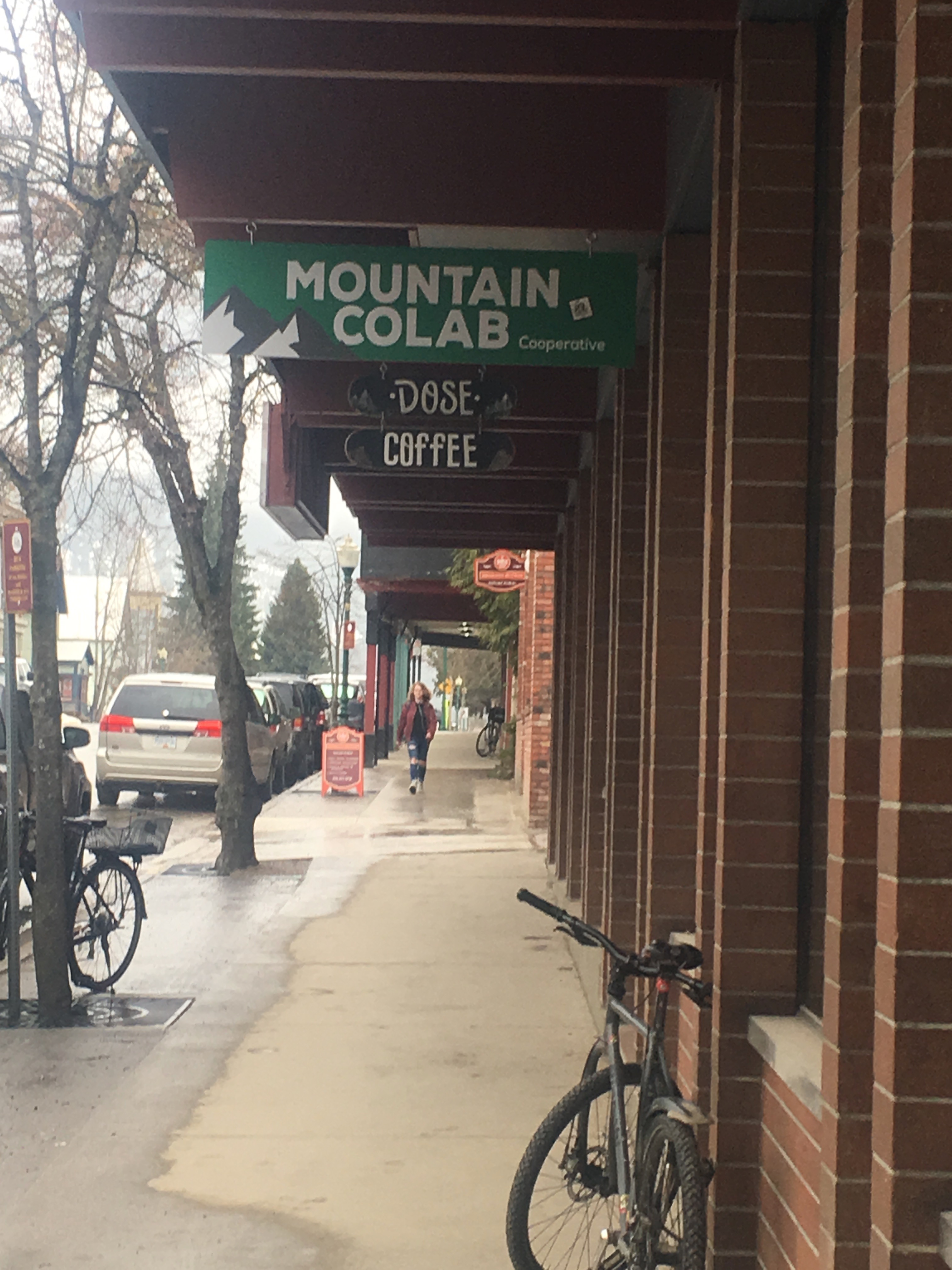
The growth in the freelance economy has prompted the emergence of co-working spaces like Revelstoke’s Mountain CoLab, catering to self-employed professionals. This is a diverse bunch, working in spaces that include tech, communications, engineering, education, design, photography, fashion, accounting, and sales, among others.
In the last few years, digital nomads have been flocking to cities like Bangkok, Berlin and Budapest where costs of living are relatively cheap and the WiFi widely available and reliable. They’ve been characterized as borderless “citizens of the world.” They aren’t quite tourists and yet, they aren’t quite residents. Co-working hubs and home-office hybrids for travelling professionals are popping up all over the place to bring together these ‘short-term expats,’ who seek social interaction, networking opportunities, a good internet connection, and a decent place to hold client meetings.
Besides the constant quest for a decent Internet connection, digital nomads base their travel decisions on cost of living in their host cities, since they usually stay in their adopted communities for longer periods of time than the typical tourist. In a town like Revelstoke, they come for the lifestyle, for outdoor recreation such as skiing, biking, hiking, and climbing. They are also looking for social support, knowledge sharing, networking, and partners to innovate with outside their professional co-workers in the other side of the planet.
Revelstoke’s Mountain CoLab provides an ideal landing spot for digital nomads and local entrepreneurs alike.
CoLab provides a beautiful, central space for entrepreneurs, freelancers, non-profits, and remote employees to work, meet, and network. Modern, shared office experiences with private and open concept facilities that include all amenities for work/life balance together with 150Mbps fibre Internet are available at very reasonable rates.
In two years of operation in Revelstoke, CoLab has grown to 50 members, and has brought hundreds of professionals, locals and digital nomads alike, together to build the community and integrate sustainable businesses.

CoLab is also part of the Mountain Coworking Alliance (MCA), a group of elite resort municipalities around the world that work together to share knowledge. Through collaboration and creativity, the MCA serves as a resource for the mountain co-working community. Through the alliance, Mountain CoLab members can work in other mountain communities at their co-working spaces and vice-versa. The partnership provides opportunities for individuals from other communities to come and work in Revelstoke throughout the year.
In its 2017 President’s Report, CoLab reports:
- Almost 40ish full time members and 100 Co-op members that have walked through the door in 2.5 years of service
- In our annual survey, we have a 99% satisfaction rate ✨
- 78% stating that you are getting more work done more than ever
- 50% saying you are meeting best friends forever BUT
- 40% really wanting more social & business collisions
- AND 80% of us are working SUPER hard for the money and 30% need more leisure time ⛷?
- The majority say we need to do more work on reducing noise, increasing privacy and help people keep focus
- BUT 92% are here for the longer term
CoLab’s collaborative ecosystem includes players such as;
- KAST & BCIC
- Startup Revelstoke
- Community Futures
- Chamber of Commerce
- RCU
- Stoke Youth Network
- WorkBC
- SmallBusinessBC
- The Global Entrepreneur Network
- Large and small local employers
- Mountain Coworking Alliance
- BC Coworking Association
We’ve only seen the start of the experience we expect to hurtle through in the next decade. Mountain CoLab will do everything it can to promote new ideals of rural life—including science, arts, technology and lifestyle.
— Jean-Marc La Flamme, President, Mountain CoLab
In the end, CoLab aspires to help build a sustainable mountain community in Revelstoke, one where business for social good succeeds with support from participating/contributing technologists, non-profits, freelancers, and entrepreneurs. Certainly bringing together a diverse mix of people, ideas, businesses, and academics under one roof helps to improve the vibrancy of Revelstoke’s downtown.
Trail — i4C Innovation
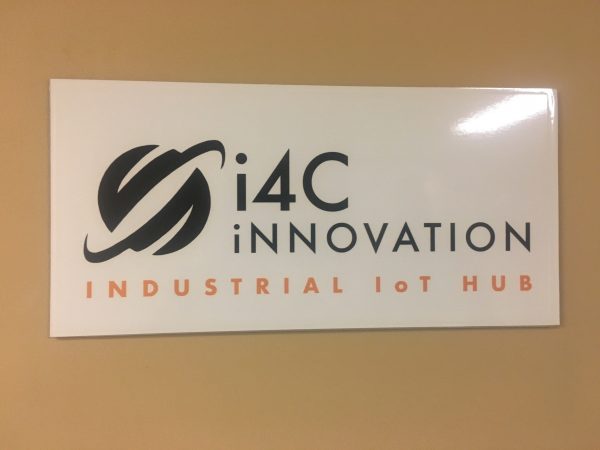
Rural innovation that works best is always rooted in some way on specific community strengths.
The Salmon Arm Innovation Centre is based on area high tech strengths revolving around the forest sector. Revelstoke is leveraging the inflow of bright young creatives attracted by its skiing and outdoor summer sports scene. In the case of the city of Trail, its many decades of metallurgical experience provides a logical foundation for the emergence of new and innovative enterprises.
Enter i4C.
The i4C Innovation hub is an Industry 4.0 lab, production & testing facility located in Trail. Its mandate is the recruitment of early stage Industry 4.0-related companies that want to run their R&D, light fabrication, commercialization, and/or distribution from a strategically located facility (Industry 4.0 is a name for the current trend of automation and data exchange in manufacturing technologies. It includes cyber-physical systems, the Internet of things, cloud computing, and cognitive computing. Industry 4.0 creates what has been called a “smart factory”).
The i4C centre sits along the newly-established Metal Tech Alley, a corridor of high-tech ventures focused on industrial innovation. The centre is situated directly opposite the Trail’s regional airport (YZZ), with ready rail access to the U.S. border, seven kilometres away.
14C offers its tenants custom-designed Industry 4.0 infrastructure, equipment, professional services, and access to venture capital with an eye toward digital technologies for industrial applications. Services include:
Sensor Assembly
I4C offers a range of efficient, precision assembly services that reduce component costs and lead-times while adhering to the highest quality standards in the industry. Manufactured quantities can range from a few pieces to full production runs.
Modular Data Centre
Manufacturing of pre-fabricated modular (PFM) containerized (shipping) and custom enclosure (purpose-built) data storage solutions to deliver self-contained distributed IT capacity. These standalone IT server units are ideal to support the demanding computing needs of businesses on and off site involved in Internet of Things and Machine-to-Machine networks.
Industrial IoT Analytics
All i4C clients have access to Astra, an augmented business intelligence platform that makes use of machine learning technology to produce descriptive, predictive and prescriptive analyses of vast amounts of IoT data. Powerful software that truly represents what the next generation of decision support systems can do.
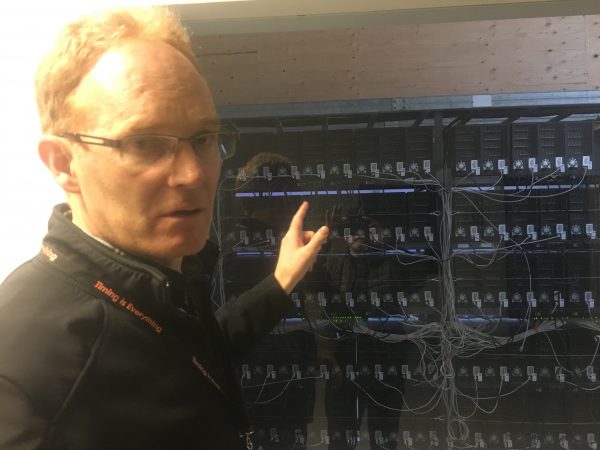
We live here. We can decide how our power is to be used. Its got to create jobs… This is an important rural strategy. This is where we can take control… and win this time.
— i4C Innovations co-founder and director, Brian Fry
The Podcast
Three rural BC towns. Three approaches to innovation, each of them based on historic strengths — very much the sort of asset-based community development approach advocated by Peter Kenyon, Cormac Russell, and others.
To get a more detail picture of the experiences of these three communities, we travelled to Salmon Arm to chat with the Innovation Centre’s Lana Fitt, to Revelstoke for a conversation with Mountain CoLab’s Jean-Marc La Flamme, and to Trail for a discussion with i4C’s Brian Fry.

